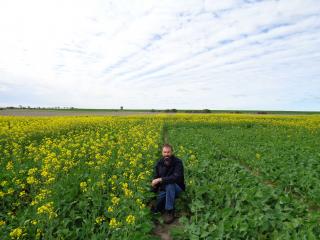Growers wanting to take advantage of early rains to sow canola need to consider making changes to their crop management and variety selection to ensure the best possible return.
Results of early sown canola trials from 2015 and 2016 as part of the Department of Agriculture and Food led tactical break crop agronomy project, funded by the Grains Research and Development Corporation (GRDC), will be presented at the GRDC Research Updates later this month.
Department research officer Martin Harries, who will speak at the updates, said in recent years, rains in March and April had provided growers with the opportunity to consider sowing canola early.
“To make this decision, growers need information on whether changes in their existing agronomy practices such as weed management and variety selection would be needed to provide the best chance of success,” he said.
Trials looking at yield potential of a range of varieties across different establishment dates were sown at Binnu on 15 April and 29 April 2015 and Wongan Hills on 31 March and 15 April 2016.
Mr Harries said results from Binnu determined that sowing in mid-April resulted in an increase in yield of about 40kg/ha per day compared to late April.
“Choosing a longer season variety for early sowing did not increase yield at this short season site.” Mr Harries said.
The highest yielding varieties were the recently released early maturity Roundup Ready hybrids while gross margins were similar between the best Roundup Ready and Triazine hybrids.
At Wongan Hills in 2016, there was also an increase in yield from sowing in late March compared to mid-April, but the benefit of 13kg/ha per day was less.
Mr Harries said variety selection at this site showed that mid-season varieties such as the 5 and 6 series lines responded best to early sowing and there was little benefit from sowing a 4 series variety in March.
Additional trials looking at crop establishment from early sowing were run across sites from Merredin to Geraldton.
These trials looked at crop establishment from mid-April sowing and how this was impacted by seed depth, seed size and if hybrid or OP varieties were sown.
Mr Harries said trials were sown at three seeding depths 1, 3 and 7 centimetres to see if chasing sub-soil moisture would improve establishment.
“Overall results showed that chasing moisture was risky. Sowing at 1cm depth and choosing a hybrid seed resulted in better crop establishment, particularly in difficult conditions,” he said.
“This information, together with the results of the variety trials, indicates to growers that most benefit from sowing canola early was achieved at mid-April while some additional benefit accrued from earlier sowing in a medium rainfall area so long as varieties with appropriate maturity were used.”
Mr Harries will also present at the Grain Research Update, Kwinana East Zone, held at the Merredin Recreation Centre on Thursday 9 March.
For more information on the GRDC’s Research Updates go to the Grain Industry Association of WA website giwa.org.au/2017researchupdates

Media contacts: Lisa Bertram/Katrina Bowers, media liaison, +61 (0)8 9368 3937/3789
